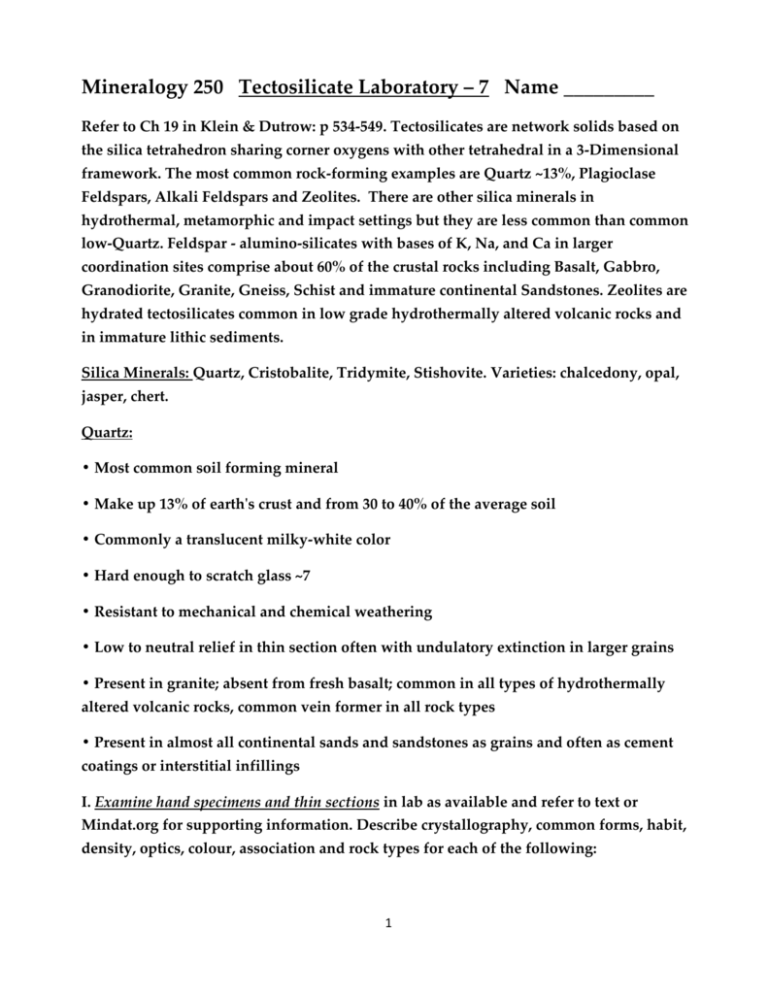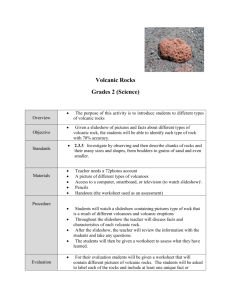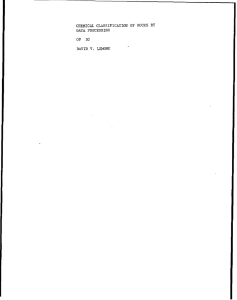Tectosilicate Laboratory 7
advertisement

Mineralogy 250 Tectosilicate Laboratory – 7 Name _________ Refer to Ch 19 in Klein & Dutrow: p 534-549. Tectosilicates are network solids based on the silica tetrahedron sharing corner oxygens with other tetrahedral in a 3-Dimensional framework. The most common rock-forming examples are Quartz ~13%, Plagioclase Feldspars, Alkali Feldspars and Zeolites. There are other silica minerals in hydrothermal, metamorphic and impact settings but they are less common than common low-Quartz. Feldspar - alumino-silicates with bases of K, Na, and Ca in larger coordination sites comprise about 60% of the crustal rocks including Basalt, Gabbro, Granodiorite, Granite, Gneiss, Schist and immature continental Sandstones. Zeolites are hydrated tectosilicates common in low grade hydrothermally altered volcanic rocks and in immature lithic sediments. Silica Minerals: Quartz, Cristobalite, Tridymite, Stishovite. Varieties: chalcedony, opal, jasper, chert. Quartz: • Most common soil forming mineral • Make up 13% of earth's crust and from 30 to 40% of the average soil • Commonly a translucent milky-white color • Hard enough to scratch glass ~7 • Resistant to mechanical and chemical weathering • Low to neutral relief in thin section often with undulatory extinction in larger grains • Present in granite; absent from fresh basalt; common in all types of hydrothermally altered volcanic rocks, common vein former in all rock types • Present in almost all continental sands and sandstones as grains and often as cement coatings or interstitial infillings I. Examine hand specimens and thin sections in lab as available and refer to text or Mindat.org for supporting information. Describe crystallography, common forms, habit, density, optics, colour, association and rock types for each of the following: 1 1. Quartz (4) 2. Cristoballite (4) 3. Tridymite (4) 4. Stishovite (4) 5. Lechatelierite (4) 6. Chalcedony (4) 7. Opal (4) 2 Feldspars •Account for 60% of the earth's crust A. Alkali Feldspar---KAlSi3O8 several mineral structures • Slightly harder than glass ~6 • Commonly white, orange, or pink in color but may be grey, blue or pale yellow • Fine wavy lines to lenses of albite in K-feldspar host may occur within crystals (perthite exsolution across prismatic cleavages) also intergrowths with quartz make graphic granite (cuneiform) • Commonly low birefringence in thin section with obvious cleavages and chalky weathering t o clays making altered grains appear turbid white or tan in PPL • Single and interpenetrant twins common: Carlsbad, Manebach, Baveno, Pericline • Flat surfaces are common (intersecting at 89-91° angles) • The most abundant mineral in granite & syenite • Is an important source of K, Na and Ba, Rb +/-Pb in soils and natural waters • Weathers to kaolinite and mixed layer clays • Common in granites, syenites, metasediments and alkaline volcanic rocks (trachytes, phonolites) II. Examine specimens and thin sections in lab as available and refer to text or Mindat.org for supporting information. Describe crystallography, common forms, habit, density, optics, colour, association and rock types for each of the following: 1. Orthoclase (5) 2. Microcline (5) 3 3. Sanidine (5) 4. Anorthoclase (5) 5. Adularia (5) 6. Celsian (5) III. Find, draw and label an exolved perthitic alkali feldspar. Label miller indices of the 2 cleavages and their interfacial angles. B. Plagioclase feldspar--NaAlSi308↔CaAl2Si2O8 complete solid solution series • Slightly harder than glass ~6 4 • Common chalky white to gray color (from almost white to dark bluish gray) • Commonly has albite twinning striations (flat faces within crystals seen as straight lines running along prism direction) other twin laws: albite, pericline, ala-a, ala-b, acline, albite-carlsbad, carlsbad. Twinning increases with Ca/Anorthite content • Commonly has multiple parallel twins for measuring optical and chemical properties, in fine grained volcanic rocks microlite extinction angle can be substituted • Labradorescence/schiller seen perpendicular to polysynthetic twinning • Flat cleavage surfaces are common (interesting at 86-94° angles) • Weathers more readily than orthoclase to calcite and mixed layer clays • Common in granodiorites, diorites, gabbros, metasediments and volcanic rocks • Phenocrysts in igneous rocks are often zoned: normal, reverse or oscillatory with respect to Ab/An contents • Composition changes optical orientation so extinction angles on cleavage fragments and other oriented sections and 2V changes with composition as well as refractive indices, birefringence and specific gravity. These are generally greater for anorthite than albite. • Composition/Varieties: Albite, Oligoclase, Andesine, Labradorite, Bytownite, Anorthite III. Examine specimens and thin sections in lab as available and refer to text or Mindat.org for supporting information. Describe crystallography, common forms, habit, density, optics, colour, association and rock types for each of the following: 1. Albite (5): Triclinic 1-bar, common in granites and felsic volcanic rocks as well as low grade metamorphic rocks… 2. Oligoclase (5) 5 3. Andesine (5) 4. Labradorite (5) 5. Bytownite (5) 6. Anorthite (5) IV. Find, draw and label a polysynthetic albite twinned plagioclase feldspar, Label miller indices of the 2 cleavages and that of the albite twine plane. Draw on the twin axis. C. Feldspathoids K, Na, Ca alumino-silicates in low-silica igneous rocks and contact metamorphics • Similar to slightly harder than glass ~5 to 6.5 • Commonly white but may be grey or blue 6 • Often as zoned phenocrysts in porphyritic alkaline undersaturated volcanic rocks, rare in plutonic rocks • Low relief minerals slightly positive to slightly negative • The most abundant mineral in granite & syenite • Is a source of K, Na, Ca in some volcanic soils and natural waters • Weathers to clays • Occurs typically in nepheline syenites, metamorphosed clayey limestones and alkaline volcanic rocks (trachytes, phonolites) but these are rare rocks 1. Leucite/Pseudo-Leucite (5) 2. Nepheline (5) 3. Cancrinite (5) 4. Sodalite (5) 4. Lazurite (5) 7 D. Scapolites Contact Metamorphic and Metasomatic “Salty-Feldspars” with complete solid solution between Marialite and Meionite. Characterized by square cross sections and 4 cleavages at 45°. While Analcime-Analcite has similar structures to these minerals they occur more commonly with feldspathoids or zeolites in volcanics. • Common white, tan, yellow, or pale green in colour • Usually a major mineral where they occur but rare overall • Used in ceramics or semiprecious gems when coloured and translucent V. Examine specimens and thin sections in lab as available and refer to text or Mindat.org for supporting information. Describe crystallography, common forms, habit, density, optics, colour, association and rock types for each of the following: 1. Marialite (formula = 2. Meionite (formula = ) (5) ) (5) 3. Analcime (5) E. Zeolites K, Na ,Ca Aluminosilicate hydrates • Low specific gravity, soft minerals common in pore spaces, amygdules and fractures in immature feldspathic or lithic sediments and all types of volcanic rocks • Common chalky white, tan, yellow, pink or salmon in colour • Dull earthy to vitreous lustre • Commonly of low relief and low birefringence, but habit is diagnostic 8 • More than 60 species have been identified, calcic ones are common in basalts, sodic and potassic ones in intermediate to felsic volcanic, forms secondary cements • Valuable as ion exchange materials in industrial applications VI. Examine specimens and thin sections in lab as available and refer to text or Mindat.org for supporting information. Describe crystallography, common forms, habit, density, optics, colour, association and rock types for each of the following: 1. Natrolite (5) 2. Chabazite (5) 3. Heulandite (5) 4. Stilbite (5) 5. Phillipsite (5) 6. Thompsonite (5) 9 7. Laumontite (5) 10







